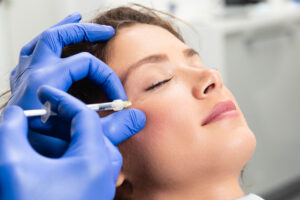Platelet-Rich Plasma Therapy (PRP) in North York
Why Wait? Discover What PRP Therapy Can Do For Your Health, Vitality & Well-Being.
What is Platelet-Rich Plasma (PRP) Therapy
Platelet-Rich Plasma (PRP) Therapy is a natural treatment that helps your body heal itself. It starts with a small blood draw, which is then spun in a machine to separate and concentrate the platelets. This rich part of your blood is then injected into the area that needs healing.
Platelets have special proteins called growth factors that help repair cells, reduce swelling, and speed up recovery. By putting these healing platelets right where they’re needed, PRP Therapy can help your body heal faster and feel better sooner.
PRP is commonly used for:
-
Musculoskeletal injuries (e.g., tendonitis, joint pain, sports injuries)
-
Hair restoration (stimulates dormant hair follicles and promotes growth)
-
Facial rejuvenation (improves skin texture, tone, and elasticity)
-
Post-surgical healing support
-
Chronic pain relief
Safe, minimally invasive, and drug-free, PRP Therapy is a cutting-edge solution for those seeking natural healing and long-term results.
How PRP Therapy Works
These platelets help the body heal and grow new, healthy tissue. The treatment starts by taking a small amount of the patient’s blood. The blood is then spun in a special machine called a centrifuge, which separates the platelets from the rest. This creates a rich, healing liquid called platelet-rich plasma (PRP).
Once it’s ready, the PRP is gently injected into the area that needs help—like a sore joint, thinning hair, or aging skin. It works by triggering the body’s natural healing process.
PRP can be made stronger by increasing the number of platelets in it—like 3, 5, 10, or even 16 times more than usual. Stronger PRP may lead to better results, depending on what you’re treating.
Conditions Treated with PRP Therapy
PRP Therapy can be used for many health and beauty problems, which makes it a flexible and useful treatment for different needs.
1. Musculoskeletal Injuries
PRP is commonly used to treat injuries involving muscles, tendons, ligaments, and joints. Conditions like tendon tears, sprains, and osteoarthritis often respond well to PRP, as the treatment accelerates healing and supports tissue regeneration.
2. Facial Rejuvenation
In aesthetics, PRP Therapy has become a powerful tool for skin rejuvenation. By stimulating collagen production, PRP helps reduce acne scars, improve skin texture and tone, tighten sagging skin, and minimize the appearance of wrinkles and fine lines.
3. Hair Restoration
PRP is also an effective treatment for hair thinning and hair loss. When injected into the scalp, it boosts blood circulation, reactivates dormant hair follicles, and promotes the growth of thicker, healthier hair.
Who Can Benefit from PRP Therapy
Medically, it can support recovery and pain relief for those dealing with:
-
Osteoarthritis
-
Tendinitis and tendon injuries
-
Ligament sprains
-
Muscle strains and joint pain
Cosmetically, PRP is ideal for patients seeking non-surgical treatments to:
-
Stimulate hair growth in cases of thinning hair or early-stage hair loss
-
Rejuvenate facial skin, improving texture, reducing wrinkles, and diminishing acne scars
-
Boost collagen production, leading to firmer, smoother skin
How Safe Is PRP Therapy
PRP Therapy is generally safe and easy for most people to handle. One of its biggest benefits is that it uses your own blood, which means there’s very little risk of allergic reactions, infection, or side effects. Since it’s a natural treatment, not made with chemicals or donor material, it’s often safer than other options. Overall, PRP offers a low-risk way to help your body heal naturally with few problems
When Is PRP Therapy Not Recommended
While PRP Therapy is generally safe and effective, there are certain conditions where it may not be suitable. It’s important to consult with a qualified healthcare provider to assess your individual risks and health status. PRP Therapy is typically not recommended in the following situations:
-
Active infections at the treatment site or elsewhere in the body
-
Blood disorders such as thrombocytopenia (low platelet count), hemophilia, or other clotting issues
-
Cancer, especially in or near the area being treated, or if undergoing active cancer treatment
-
Pregnancy, as a precaution to avoid any potential risk to the mother or the baby
-
Uncontrolled chronic conditions, including severe diabetes, autoimmune disorders, or advanced cardiovascular disease
What Makes PRP Therapy Effective
Platelet-Rich Plasma Therapy (PRP) is effective because it uses your body’s natural healing abilities. By concentrating platelets and growth factors from your blood, PRP helps stimulate tissue repair, reduce inflammation, and speed up healing. This therapy promotes:
-
Collagen production for smoother, firmer skin
-
Tissue regeneration and repair in muscles, tendons, and joints
-
Reduced inflammation for conditions like osteoarthritis and tendinitis
-
Healing of skin issues such as acne scars and signs of aging
Is PRP Therapy Painful
PRP Therapy is usually easy to handle and not very painful. Most people feel only a small pinch during the injection. If you’re sensitive to pain, a numbing cream or local anesthetic can be used to make you more comfortable. Some mild side effects like swelling, redness, or bruising might happen, but they usually go away in a few days
Are There Medical Studies That Support PRP Therapy
Yes, a growing body of medical research and clinical studies supports the effectiveness of Platelet-Rich Plasma Therapy (PRP) for a wide range of conditions. Studies have documented improvements in joint function for patients with osteoarthritis, accelerated healing of soft tissue injuries, and noticeable enhancements in skin texture and hair regrowth.
A Modern Approach to Healing and Regeneration
Whether you’re recovering from an injury, addressing signs of aging, or exploring new ways to feel your best, PRP Therapy offers a promising path forward rooted in science, supported by research, and guided by the body’s own healing power.
Why wait? Discover what PRP Therapy can do for your health, vitality, and well-being.
Links:
https://www.ncbi.nlm.nih.gov/pmc/articles/PMC8922312/
https://www.ncbi.nlm.nih.gov/pmc/articles/PMC8182581/
https://www.ncbi.nlm.nih.gov/pmc/articles/PMC8606573/
https://www.ncbi.nlm.nih.gov/pmc/articles/PMC6220013/
https://link.springer.com/article/10.1007/s10561-022-10039-z

